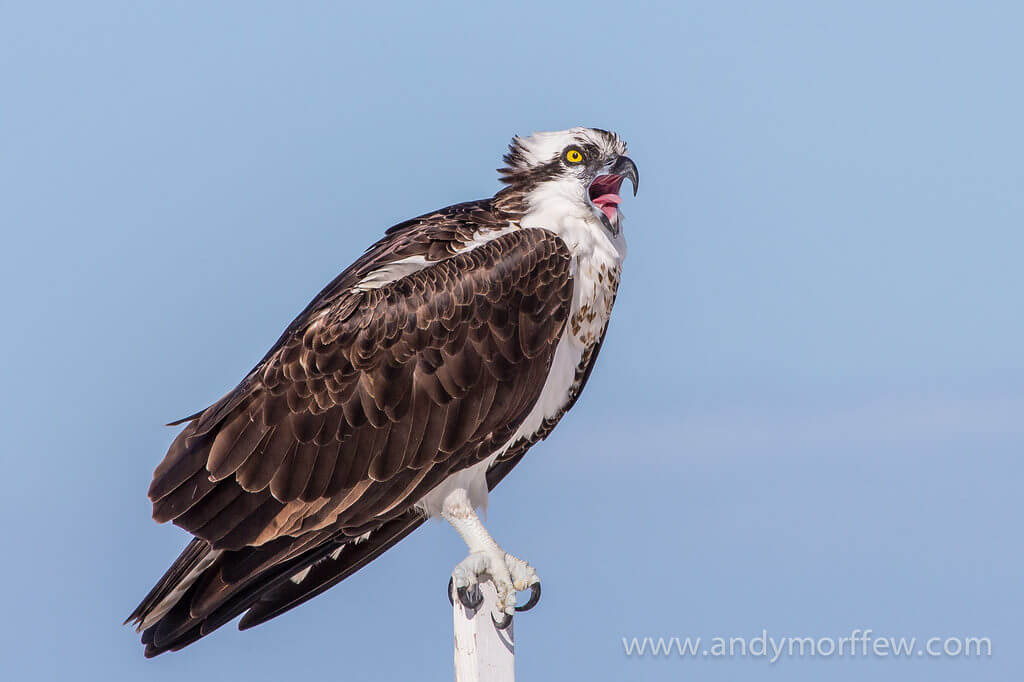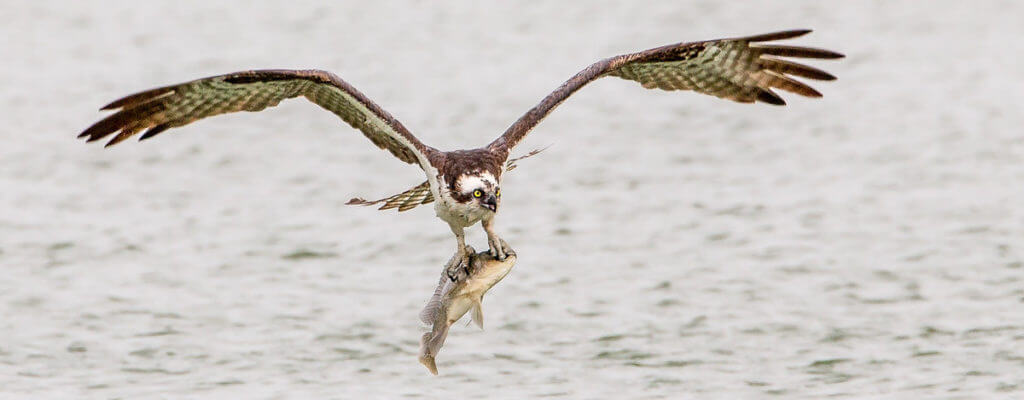By Jenélle Dowling
I’ve always loved birds, but I started to really pay attention to them after college. And Ospreys made their way onto my radar very quickly. The first time I interacted with an Osprey, she didn’t just catch my attention, she demanded my attention. I was working for the Smithsonian Migratory Bird Center, researching songbirds on the eastern shore of Maryland, near my hometown of Baltimore. I heard the Osprey before I saw her, and I assumed this bird must be huge, and boisterous. I was right, what volume! I spotted her atop a huge conifer, and saw that she was communicating with her mate, who was in flight nearby. I was thoroughly transfixed by this first meeting.
Osprey giving the “screaming call”:
Recording by Paul Marvin, accessed on Xeno-canto.org: XC225658

a female Osprey calling for her mate
Fast forward in time through a few years of bird field research, graduate school, post-doctoral teaching, and a cross country move, and I now run the Wings Over Water Osprey Education Program at the Montana Natural History Center, in collaboration with UM Professor Erick Greene.
Since I’ve started working with Ospreys, I’ve had the chance to hear others’ stories of their interactions with Ospreys, and many are similar to mine: these magnificent raptors just can’t be ignored. Ospreys are a captivating species, and folks of all ages can’t help but stop and watch their fascinating behavior. Spend a few moments watching their courtship, their expert angling, or their impressive sky dance, and you’ll want to know more. This is the reason that Dr. Greene started his public outreach and education work with Ospreys, more than ten years ago.

photo by Andy Morffew
Now, MNHC has teamed up with Dr. Greene to create the Wings Over Water Osprey Education program, a collaborative project with Raptor View Research Institute, MPG ranch, NASA’s Montana Space Grant Consortium, and many others. The educational approach of the WOW program works on two levels: we prepare teachers to teach advanced science, technology, engineering, and math (STEM) lessons in their classrooms, and we directly engage students in STEM research in middle school, a critical age for keeping kids in STEM fields.
This June, we will host our first WOW Summer Institute at UM. We’ve accepted six exceptional middle-school teachers to this year’s training program. These teachers represent schools from across Western Montana: Seeley Lake Elementary, Corvallis Middle School, Stevensville Middle School, Lone Rock School, and Dixon School. Teachers in the program will join us in the field as we band and take blood samples from Osprey chicks, they’ll see how samples are analyzed in UM’s state-of-the-art Environmental Biogeochemistry lab, and they’ll learn from experts about how the health of these Osprey chicks can tell us in great detail about the health of the entire Clark Fork watershed. We’ll also witness research on bird flight physics in action with Bret Tobalske in the UM flight Laboratory, work with Jen Fowler to see how drones are used for research in the Autonomous Aerial Systems Office, and discover how satellites help guide our daily lives with aerospace engineer Rodrigo Zeledon from Lockheed Martin.
During the school year, students in the WOW program will work through a full-year STEM curriculum based on Ospreys. To give a few examples from the curriculum, students will do live satellite tracking of migrating Ospreys, they will use engineering practices to design solutions to problems in our watershed, and they will join us on a field trip to observe behavior at an Osprey nest near their school.

We’re so excited to get the WOW program started. We hope that you will join us—whether you’re a student, a teacher, or just an Osprey enthusiast, come see us at MNHC and ask about upcoming programs with Ospreys!
To learn more about Ospreys and the history of the WOW program, watch our new video:












